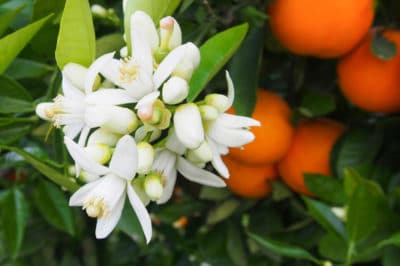Orange Tree Flowers and Brides
The Chinese began growing sweet orange trees (Citrus sinensis) more than a thousand years ago. Since then, appreciation of their flowers has across many cultures:
- Emblems of orange blossoms first adorned the wedding gowns of Chinese brides as a sign of eternal love, innocence, fruitfulness and good fortune.
- The orange-blossom embossed wedding gown tradition gradually spread to India and what is now Iran. In 987 A.D., the Courtyard of Oranges was planted at the Mesquita mosque in Cordoba, Spain. It contained sour orange trees (Citrus aurantium) — which the ruling Caliphs also had planted in public squares throughout Andalusia in southern Spain. In culinary circles, they’re now known as Seville oranges.
- The Southern and Central Europeans harvested sour orange tree flowers for their scent until the 15th century. Then they switched to sweet orange flowers because the trees also produced edible fruit.
- When Queen Victoria wed Prince Albert in February of 1840, she started a tradition by wearing sweet orange blossoms in her hair.
Orange Tree Flowers and Neroli Oil
Sour orange tree flowers make one of the world’s costliest and intensely scented essential oils. Almost 630 pounds (187 liters) of them go into a single cup (236 ml) of Neroli oil.
Neroli oil takes its name from Princess Anne Marie Orsini of Nerola, Italy. It had been regarded as medicine until she began washing with and wearing it in the 17th century.
Neroli Absolute Oil
Neroli absolute oil is released when sour orange flowers are combined with a solvent. Also called Orange Blossom Absolute, it’s said to have a more flowery, longer-lasting fragrance than Neroli oil.
Eating Orange Tree Flowers
Although orange tree flowers are edible, their flavor doesn’t compare to their scent. But infused orange flower water is magical when used in a host of North African dishes, from Chicken Bastilla to Moroccan rice pudding.
To make the water, mash fresh, well-rinsed sour orange flower petals with a ceramic mortar and pestle. After several hours, place them in a glass jar and barely cover them with distilled water. Close the jar and place it in direct sun for at least two weeks.
When its scent is strong enough, strain the water into smaller sterilized jars. It keeps indefinitely in the refrigerator.
